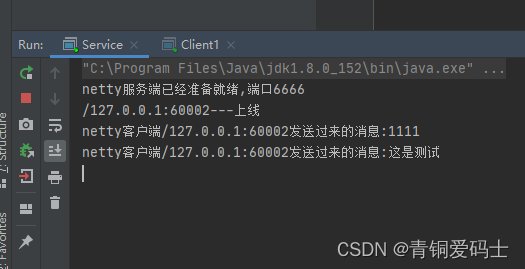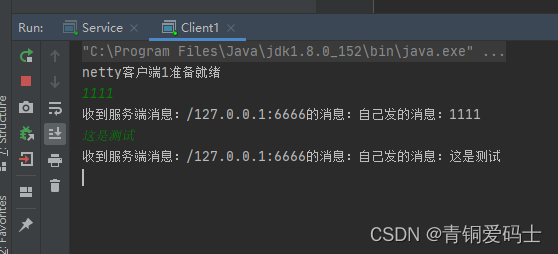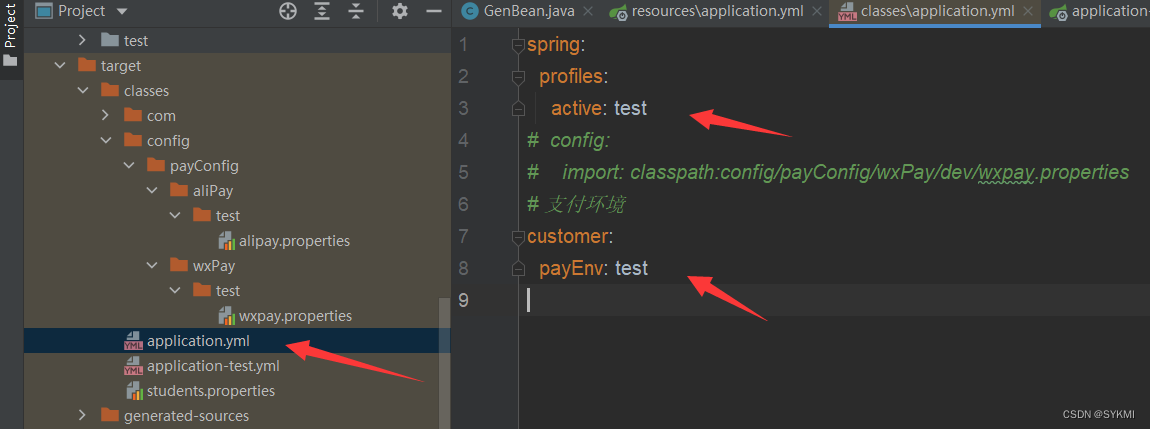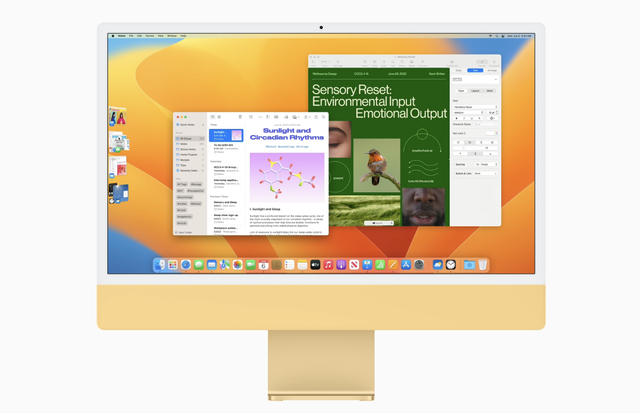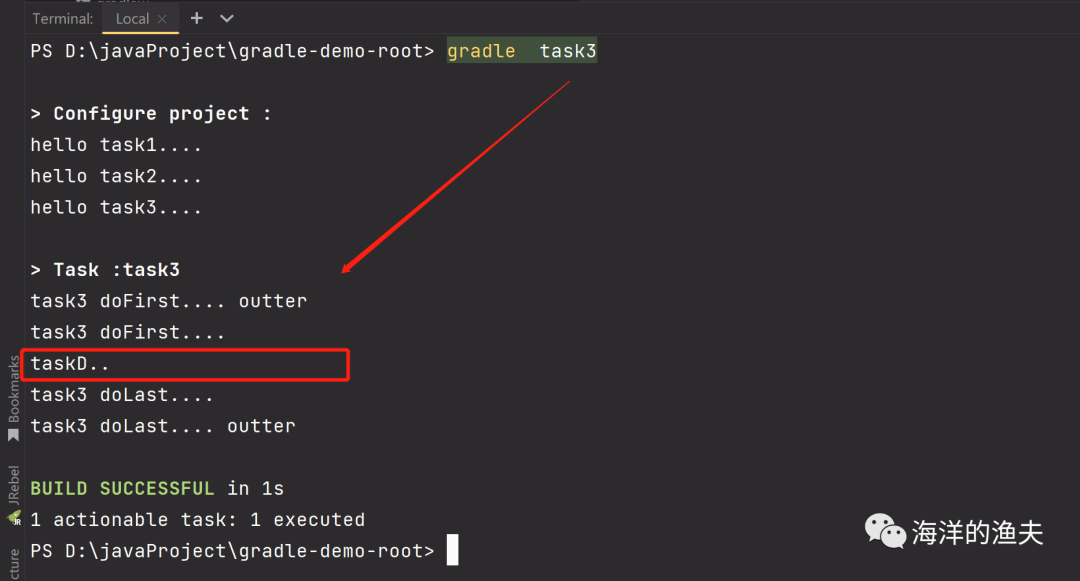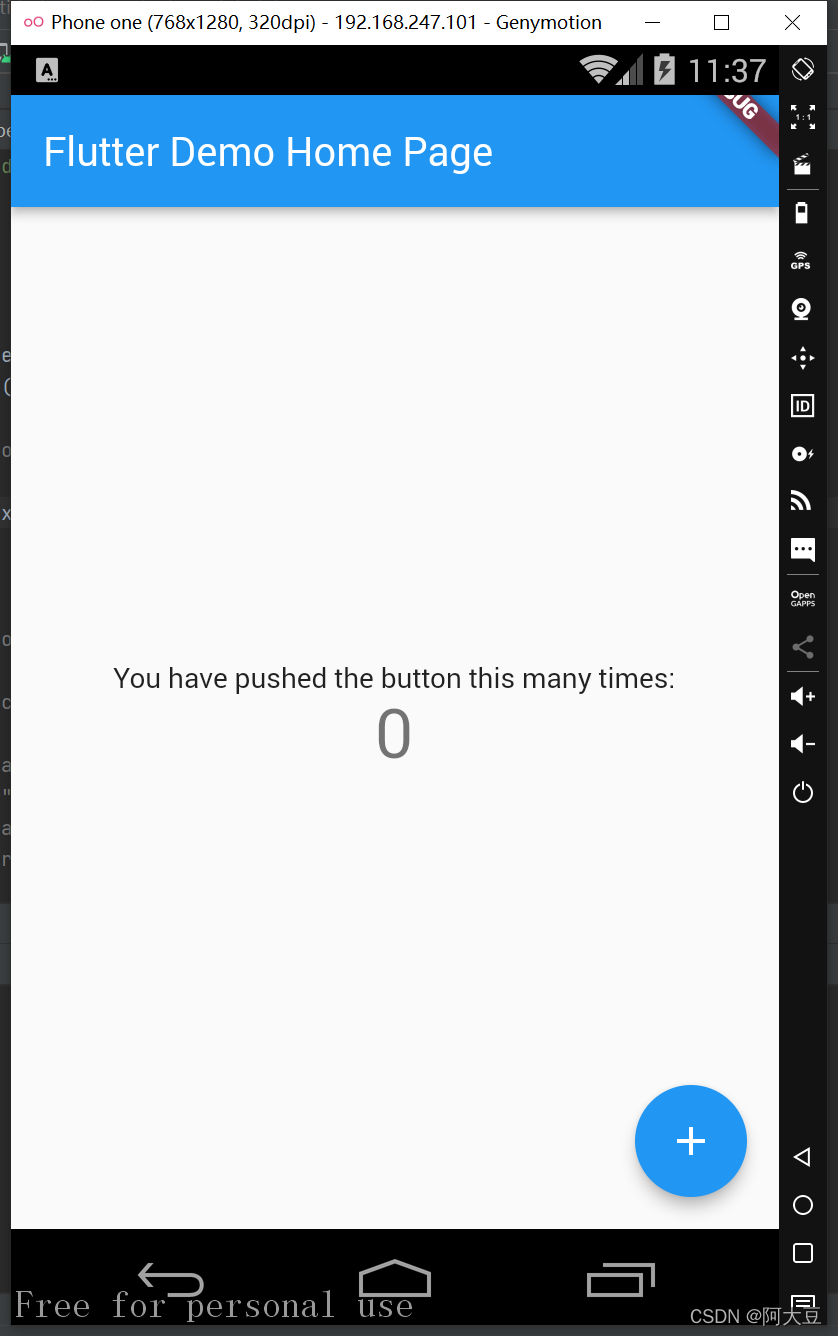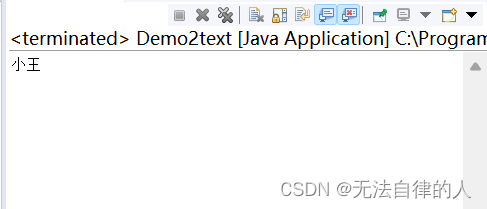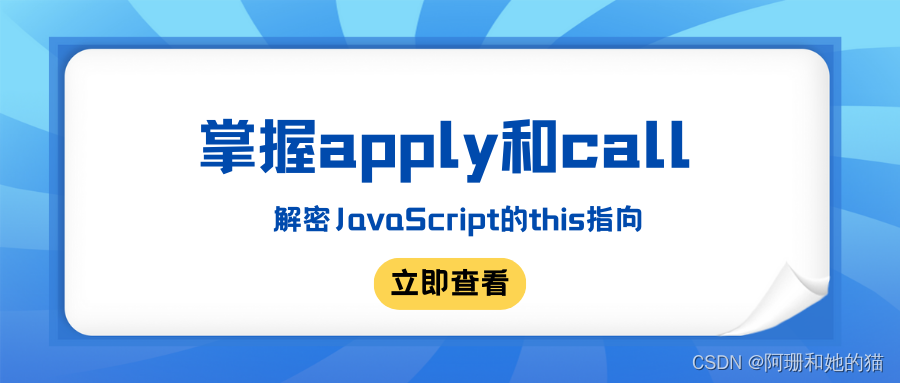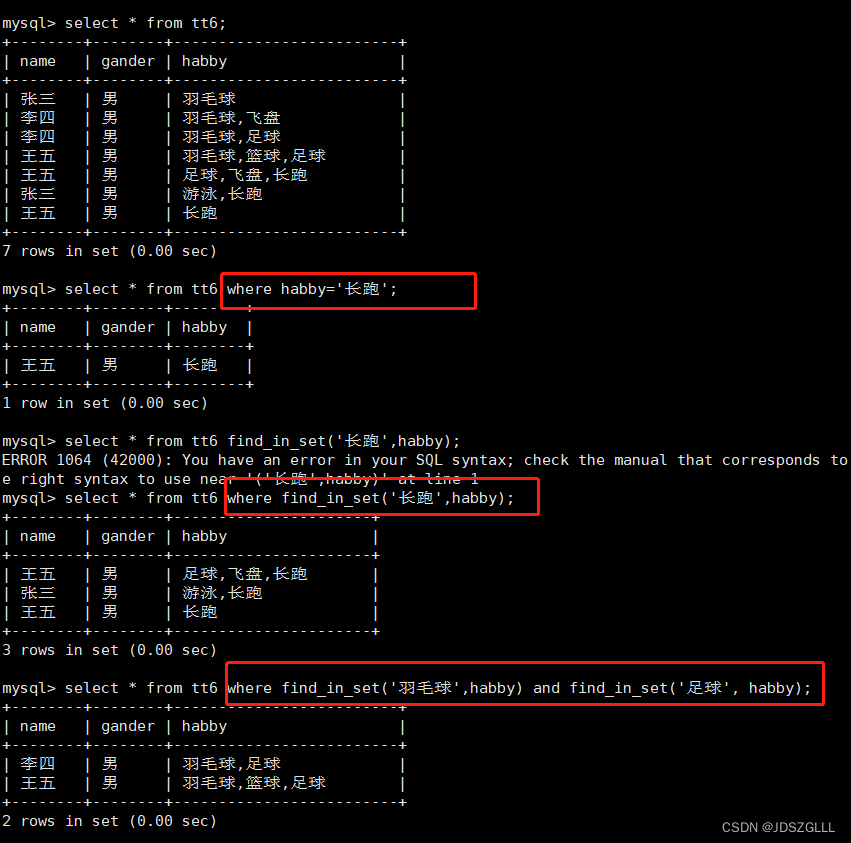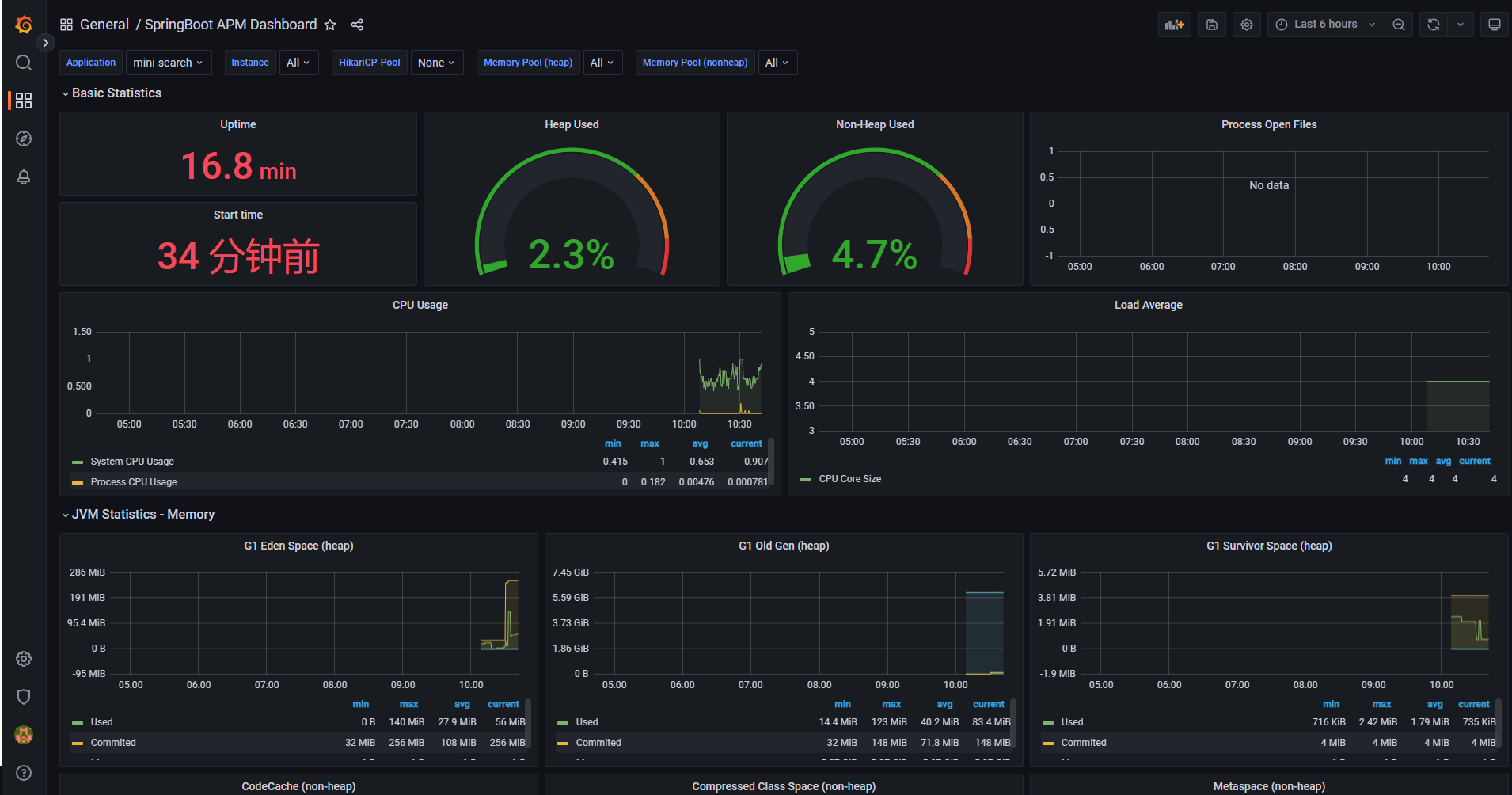1. 新建maven工程,添加netty依赖
<?xml version="1.0" encoding="UTF-8"?>
<project xmlns="http://maven.apache.org/POM/4.0.0"
xmlns:xsi="http://www.w3.org/2001/XMLSchema-instance"
xsi:schemaLocation="http://maven.apache.org/POM/4.0.0 http://maven.apache.org/xsd/maven-4.0.0.xsd">
<modelVersion>4.0.0</modelVersion>
<groupId>org.example</groupId>
<artifactId>nettyTest</artifactId>
<version>1.0-SNAPSHOT</version>
<build>
<plugins>
<plugin>
<groupId>org.apache.maven.plugins</groupId>
<artifactId>maven-compiler-plugin</artifactId>
<configuration>
<source>8</source>
<target>8</target>
</configuration>
</plugin>
</plugins>
</build>
<dependencies>
<dependency>
<groupId>io.netty</groupId>
<artifactId>netty-all</artifactId>
<version>4.1.34.Final</version>
</dependency>
</dependencies>
</project>
2. 新建netty服务器
package server;
import io.netty.bootstrap.ServerBootstrap;
import io.netty.channel.*;
import io.netty.channel.nio.NioEventLoopGroup;
import io.netty.channel.socket.SocketChannel;
import io.netty.channel.socket.nio.NioServerSocketChannel;
import io.netty.handler.codec.LineBasedFrameDecoder;
import io.netty.handler.codec.string.StringDecoder;
import io.netty.handler.codec.string.StringEncoder;
import java.util.concurrent.ConcurrentHashMap;
public class NettyService {
/**
* 1.创建BossGroup线程组,处理网络连接事件
* 2.创建workerGroup线程组 处理网络读写事件
* 3.创建服务端启动助手,serverBootStrap
* 4.设置服务端通道实现方式为NIO
* 5.设置服务端options
* 6.创建通道初始化对象
* 8.向pipeline中添加自定义业务初处理逻辑handler
* 9.启动服务端并绑定端口,将异步改为同步
* 10.关闭通道和连接池
*/
//监听的端口号
private final int port;
public NettyService(int port) {
this.port = port;
}
public void createNettyService() {
//创建两个线程组 boosGroup、workerGroup,这两个都是无限循环,boos是负责进行连接请求的接收accept事件,而worker则是负责业务处理
//只是处理连接请求accept,含有的子线程有多少个呢,NioEventLoop个数,默认是cpu的核数*2
EventLoopGroup bossGroup = new NioEventLoopGroup();
//真正的和客户端进行业务处理,含有的子线程有多少个呢,NioEventLoop个数,默认是cpu的核数*2
EventLoopGroup workerGroup = new NioEventLoopGroup();
try {
//创建服务端的启动对象,设置参数
ServerBootstrap bootstrap = new ServerBootstrap();
//设置两个线程组boosGroup和workerGroup
bootstrap.group(bossGroup, workerGroup)
//设置服务端通道实现类型
.channel(NioServerSocketChannel.class) //使用nioserversocketchannel作为通道实现
//设置线程队列得到连接个数
.option(ChannelOption.SO_BACKLOG, 128) //设置线程队列等待连接个数
//设置保持活动连接状态
.childOption(ChannelOption.SO_KEEPALIVE, true)
//使用匿名内部类的形式初始化通道对象
.childHandler(new ChannelInitializer<SocketChannel>() {
//这里会进行客户端业务处理
//通过一个特殊的ChannelInboundHandler 来初始化注册到EventLoop的Channel
@Override
protected void initChannel(SocketChannel sc) throws Exception {
//给pipeline管道设置处理器
ChannelPipeline pipeline = sc.pipeline();
//添加一个基于行的解码器
pipeline.addLast(new LineBasedFrameDecoder(2048));
pipeline.addLast(new StringDecoder());
pipeline.addLast(new StringEncoder());
//这里加入了自定义的handler
pipeline.addLast(new NettyServiceHandler());
}
});//给workerGroup的EventLoop对应的管道设置处理器
//绑定端口号,启动服务端
ChannelFuture channelFuture = bootstrap.bind(port).sync();
System.out.println("netty服务端已经准备就绪,端口" + port);
//对关闭通道进行监听
channelFuture.channel().closeFuture().sync();
} catch (InterruptedException e) {
e.printStackTrace();
} finally {
bossGroup.shutdownGracefully();
workerGroup.shutdownGracefully();
}
}
}
自定义handler
package server;
import io.netty.buffer.ByteBuf;
import io.netty.buffer.Unpooled;
import io.netty.channel.*;
import io.netty.channel.group.ChannelGroup;
import io.netty.channel.group.DefaultChannelGroup;
import io.netty.util.CharsetUtil;
import io.netty.util.concurrent.GlobalEventExecutor;
/**
* 自定义处理Handler
*/
public class NettyServiceHandler extends SimpleChannelInboundHandler<String> {
// 创建一个ChannelGroup,其是一个线程安全的集合,其中存放着与当前服务器相连接的所有Active状态的Channel
// GlobalEventExecutor是一个单例、单线程的EventExecutor,是为了保证对当前group中的所有Channel的处理
// 线程是同一个线程
//private static ChannelGroup group = new DefaultChannelGroup(GlobalEventExecutor.INSTANCE);
// 只要有客户端Channel与服务端连接成功就会执行这个方法
@Override
public void channelActive(ChannelHandlerContext ctx) throws Exception {
// 获取到当前与服务器连接成功的channel
Channel channel = ctx.channel();
System.out.println(channel.remoteAddress() + "---上线");
//group.writeAndFlush(channel.remoteAddress() + "---上线\n");
// 将当前channel添加到group中
//group.add(channel);
// NettyService.remoteAddressMap.put(channel.remoteAddress().toString(), ctx);
}
// 只要有客户端Channel断开与服务端的连接就会执行这个方法
@Override
public void channelInactive(ChannelHandlerContext ctx) throws Exception {
// 获取到当前要断开连接的Channel
Channel channel = ctx.channel();
System.out.println(channel.remoteAddress() + "------下线");
//group.writeAndFlush(channel.remoteAddress() + "下线,当前在线人数:" + group.size() + "\n");
// group中存放的都是Active状态的Channel,一旦某Channel的状态不再是Active,
// group会自动将其从集合中踢出,所以,下面的语句不用写
// remove()方法的应用场景是,将一个Active状态的channel移出group时使用
// group.remove(channel);
}
/**
* channelRead,这个方法当有数据读写的时候,会触发,可以读取客户端的消息
* 只要有客户端Channel给当前的服务端发送了消息,那么就会触发该方法的执行
*/
@Override
protected void channelRead0(ChannelHandlerContext ctx, String msg) throws Exception {
Channel channel = ctx.channel();
System.out.println("netty客户端" + channel.remoteAddress() + "发送过来的消息:" + msg);
channel.writeAndFlush("自己发的消息:" + msg + "\n");
// String[] split = msg.split(":");
// if (split.length >= 2) { //指定客户端时发送给指定客户
// System.out.println("发送给客户:" + split[0]);
// if (NettyService.userIdMap.get(split[0]) != null) {
// NettyService.userIdMap.get(split[0]).writeAndFlush(channel.remoteAddress() + ":" + split[1] + "\n");
// } else {
// NettyService.userIdMap.put(split[0], ctx); //第一次发送消息时注册客户端的channel
// }
// } else { //否则发送给所有的客户端
// System.out.println("广播");
// // 遍历channelGroup,从而区分“我”和“别人”发出的消息,如果消息是自己发出的就显示“我”
// group.forEach(ch -> { // JDK8 提供的lambda表达式
// if (ch != channel) {
// ch.writeAndFlush(channel.remoteAddress() + ":" + msg + "\n");
// } else {
// channel.writeAndFlush("自己发的消息:" + msg + "\n");
// }
// });
// }
}
/**
* channelReadComplete,数据读取完毕之后,需要做的业务操作,回消息
*/
// public void channelReadComplete(ChannelHandlerContext channelHandlerContext) throws Exception {
// //消息出站
// System.out.println("Netty服务端读取消息完毕");
// channelHandlerContext.writeAndFlush(Unpooled.copiedBuffer("--over", CharsetUtil.UTF_8));
// }
/**
* exceptionCaught,发生异常的handler
*/
public void exceptionCaught(ChannelHandlerContext channelHandlerContext, Throwable throwable) throws Exception {
throwable.printStackTrace();
channelHandlerContext.close();
}
}
3. 新建客户端
package client;
import io.netty.bootstrap.Bootstrap;
import io.netty.channel.*;
import io.netty.channel.nio.NioEventLoopGroup;
import io.netty.channel.socket.SocketChannel;
import io.netty.channel.socket.nio.NioSocketChannel;
import io.netty.handler.codec.LineBasedFrameDecoder;
import io.netty.handler.codec.string.StringDecoder;
import io.netty.handler.codec.string.StringEncoder;
import java.io.BufferedReader;
import java.io.IOException;
import java.io.InputStreamReader;
import java.nio.charset.StandardCharsets;
public class NettyClient {
/**
* 1.创建线程组
* 2.设置线程组启动助手 bootstrap
* 3.设置客户端通道为NIO
* 4.创建通道初始化对象
* 5.向pipeline中添加自定义业务处理的handler
* 6.启动客户端,等待链接服务端,同时将异步改为同步
* 8.关闭通道和连接池
*/
private final String host;
private final int port;
public NettyClient(String host, int port) {
this.host = host;
this.port = port;
}
public void createNettyClient() {
//客户端跟服务端有些许区别,第一个就是不需要两个loopgroup了,不需要使用boosgroup了,所以只需要新建一个loopgroup来处理业务就行了
EventLoopGroup group = new NioEventLoopGroup();
try {
//第二点就是不是使用serverBootstrap,而是使用bootstrap
Bootstrap bootstrap = new Bootstrap();
//设置线程组
bootstrap.group(group)
.channel(NioSocketChannel.class) //设置客户端的通道实现类型
.handler(new ChannelInitializer<SocketChannel>() {
@Override
protected void initChannel(SocketChannel ch) throws Exception {
ChannelPipeline pipeline = ch.pipeline();
pipeline.addLast(new LineBasedFrameDecoder(2048));
pipeline.addLast(new StringDecoder());
pipeline.addLast(new StringEncoder());
pipeline.addLast(new NettyClientHandler()); //加入自己的处理器
}
});
//启动客户端
ChannelFuture future = bootstrap.connect(host, port).sync();
System.out.println("netty客户端1准备就绪");
// 获取键盘输入
InputStreamReader is = new InputStreamReader(System.in, StandardCharsets.UTF_8);
BufferedReader br = new BufferedReader(is);
// 将输入的内容写入到Channel
while (true) {
//br.readLine()中执行fill()方法获取输入数据,获取不到时会发生阻塞,直到获取到数据为止
future.channel().writeAndFlush(br.readLine() + "\r\n");
}
//监听通道关闭的状态事件
//channel.closeFuture().sync();
} catch (InterruptedException | IOException e) {
e.printStackTrace();
} finally {
//关闭通道和连接池
group.shutdownGracefully();
}
}
}
自定义handler
package client;
import io.netty.channel.ChannelHandlerContext;
import io.netty.channel.SimpleChannelInboundHandler;
/**
* 自定义处理Handler
*/
public class NettyClientHandler extends SimpleChannelInboundHandler<String> {
/**
* channelActive,当通道就绪,就会触发该方法
*/
// public void channelActive(ChannelHandlerContext channelHandlerContext) throws Exception {
// //发送消息到服务端
// channelHandlerContext.writeAndFlush(Unpooled.copiedBuffer("netty客户端1启动.", CharsetUtil.UTF_8));
// }
// public void channelInactive(ChannelHandlerContext channelHandlerContext) throws Exception {
//
// }
/**
* channelRead,当通道有读取事件时,会触发
*/
public void channelRead0(ChannelHandlerContext channelHandlerContext, String msg) throws Exception {//接收服务端发送过来的消息
System.out.println("收到服务端消息:" + channelHandlerContext.channel().remoteAddress() + "的消息:" + msg);
}
/**
* exceptionCaught,当有异常的就会触发
*/
public void exceptionCaught(ChannelHandlerContext channelHandlerContext, Throwable throwable) throws Exception {
channelHandlerContext.close();
}
}
4. 测试
启动服务器
package test;
import server.NettyService;
public class Service {
public static void main(String[] args) {
new NettyService(6666).createNettyService();
}
}
启动客户端
package test;
import client.NettyClient;
public class Client1 {
public static void main(String[] args) {
new NettyClient("127.0.0.1",6666).createNettyClient();
}
}
